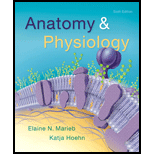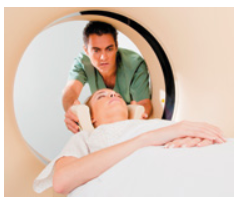
Concept explainers
39-Year-Old Female with Traumatic Brain Injury
Margaret Bryans, a 39-year-old female, lost control while skiing and hit her head on a tree. She regained consciousness en route to the hospital and appeared agitated and combative. Paramedics observed that she had a right hemiparesis (muscle weakness), with a nearly complete paresis of her right upper extremity and a partial paresis of the right lower extremity. A head CT scan revealed an acute subdural hematoma and an extensive subarachnoid hemorrhage. Doctors noted that she was able to follow commands from medical personnel. However, she could only speak haltingly, using simple words.

Surgery to remove large clots from the subarachnoid space was performed immediately. Two weeks after the surgery, she showed significant improvement in her speech and motor function.
5. NCLEX-STYLE Mrs. Bryan’s subdural and subarachnoid bleeding most likely interfered directly with which of the following?
a. The blood supply to the scalp
b. The blood supply to the cerebral cortex
c. The removal of cerebrospinal fluid
d. The creation of cerebrospinal fluid
Want to see the full answer?
Check out a sample textbook solution
Chapter 12 Solutions
Anatomy & Physiology (6th Edition)
- Mrs. Giammo asks, "How is what I had different from a stroke?" Provide a simple explanation of how a transient ischemic attack (TIA) differs from a cerebrovascular accident (CVA, stroke).arrow_forwardA 21-year-old male medical student is taken to the ER by his roommates complaining of progressive weakness. The history reveals that this student had an intestinal virus with diarrhea and vomiting that resolve over 2 days. About 10 days later, he noticed tingling sensations and numbness in his feet, followed by progressive weakness. Over the last 8 days it has gotten so bad that he is having trouble standing, and walking. His physical examination shows normal cranial nerves, distal weakness of the lower extremities (about 3+/5), absent reflexes over the lower extremities, and mild decreased vibration and position sense loss. 1. What is your differential diagnosis? 2. Where is the lesion? 3. Which diagnostic test would you perform first and why? 4. What is the most likely diagnosis and why?arrow_forwardnial Plexus Q/A A 44-year-old man presents to the emergency department with pain in the right arm following a motorcycle accident. Examniation revelaed a fractured medial epicondyle and the clawing of the ring and little finger on the right hand. eko Which of the following best describes the nerve most affected in this case? Saving your path O A: Axillary B: Median C: Musculocutaneous D: Radial E: Ulnararrow_forward
- Define the following terms and include histologic changes causing/contributory to the disorder. 1. Epilepsy2. Multiple Sclerosis3. Transient Ischemic Attack4. Parkinson’s Disease5. Cerebrovascular Accidentarrow_forwardA client just experienced a cerebrovascular accident. As a result of the cva the client develops dysphasia along with a sudden headache. Briefly describe material facts relative to 1) dysphasia 2) headachearrow_forwardMeet Mr. Bergen Mr. Bergen, a 72-year-old man, is admitted to the hospital due to an acute onset of a right facial droop, right arm weakness, and difficulty speaking coherently. His symptoms started 6 hours prior while sitting at his kitchen table. He had no headache, loss of consciousness, and no abnormal motor movements. His medical history includes high blood pressure and a heart attack five years ago. His medications include a daily aspirin, and he has been a lifelong smoker. His temperature is normal, his heart rate is 62 beats per minute, and his blood pressure is 135/87. The rest of his neurological and physical exam is normal his heart rhythm is normal, and his blood tests all come back normal. Overview When first trying to put together the factors involved in making a diagnosis from a medical case study, a good place to start is making a set of general observations about the patient. These observations include the patient's history, set of symptoms, general appearance and…arrow_forward
- "Nursing"_Patient X had a malignant duodenal tumor that was removed. The surgeon removed the whole duodenum. Predict the long-term consequences for Patient X after recovery.arrow_forwardPatient X had a malignant duodenal tumor that was removed. The surgeon removed the whole duodenum. Predict the long-term consequences for Patient X after recoveryarrow_forwardMr. Q, age 64 years, developed a severe headache several hours ago that has not responded to acetaminophen (Tylenol). Now his speech is slurred, and his right arm and the right side of his face feel numb. He is very anxious and is transported to the hospital. Mr. Q has a history of smoking and arteriosclerosis, and there is a family history of CVA(Cerebrovascular Accident) and diabetes. Assessment at the hospital indicated weakness on the right side, including facial asymmetry and blood pressure of 220/110 Hg mm. A CT scan showed damaged tissue on the left side of the brain, and an angiography indicated a narrowing of the carotid arteries and middle cerebral arteries, with occlusion of the left middle cerebral artery. Explain the predisposing factors in this case, and relate Mr. Q’s initial signs to the pathological changes. Discuss the different types of disabilities That Mr.Q will face and possible treatments plans?arrow_forward
- A 50 year old patient suddenly exhibits hemiplegia without evidence of head or neck trauma and without increased intracranial pressure. What could be a possible cause? O subarachnoid hemorrhage O brain contusion cerebral palsy spina bifida O Huntington's disease O cerebrovascular accidentarrow_forward35-year-old diagnosed with M.S. presents to clinic after experiencing intermittent generalized weakness and blurred vision. She also complains of feeling an “electric shock” down her spine and chronic fatigue. She reports feeling this way for around a year, but it appears to be getting gradually worse over time. All blood tests for M.S. are normal. MRI reveals small plaques throughout brain. A diagnosis of multiple sclerosis is made. What possible factors might triggers her condition, related to her MS?arrow_forwardCompare the signs of spinal shock with the permanenteffects of spinal cord injuryarrow_forward
 Medical Terminology for Health Professions, Spira...Health & NutritionISBN:9781305634350Author:Ann Ehrlich, Carol L. Schroeder, Laura Ehrlich, Katrina A. SchroederPublisher:Cengage Learning
Medical Terminology for Health Professions, Spira...Health & NutritionISBN:9781305634350Author:Ann Ehrlich, Carol L. Schroeder, Laura Ehrlich, Katrina A. SchroederPublisher:Cengage Learning- Understanding Health Insurance: A Guide to Billin...Health & NutritionISBN:9781337679480Author:GREENPublisher:CengageSurgical Tech For Surgical Tech Pos CareHealth & NutritionISBN:9781337648868Author:AssociationPublisher:Cengage




